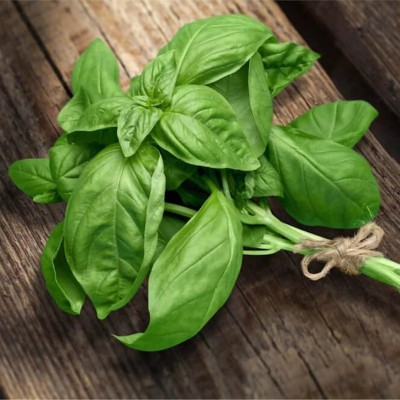XEFRA Italian Large Leaf Basil Organic Seed(100 per packet)
Quick Overview
Product Price Comparison
About this itemWhere to grow: Balcony or terrace gardenSowing season: Throughout the year (spring and summer)Mode of sowing: Sow the seeds 0.5 cm or 1/4 inches deep in a Container, or Pots.Germination temperature: 21-25┬░CGermination Time: 7 to 14 days from sowingHarvest: 50-70 daysPlant vigor: Strong plantWhat size grow bag is best for Basil?12 x 12 Inch (W*H)15 x 15 Inch (W*H)Basil Plant Growing Season In IndiaYou can grow basil in any season throughout the year indoors. The best season for sowing basil seeds are spring and summer when the soil is warm.How To Grow Basil At HomeBasil seeds can be sown directly in pots or by transplanting, if you want the best results for the basil plants then you need to transplant them into bigger pots after seed germination. Choose a seedling tray or small pot (up to 3 inches deep) and a final pot or grow bag (12-15 inches deep and wide) with well-draining holes. Basil seeds will germinate faster at 21-25┬░C temperature. Basil is a perennial herb, so you need to repot it every year.Basil Seeds Sowing MethodSow basil seeds in the seedling tray with a potting mix about 0.5 cm or 1/4 inches deep. Give light water through a water sprayer. Keep the seedling tray in a location where it receives medium and bright sunlight and keep the soil moist. Basil large leaf seeds will germinate within 7-14 days (depending on growing conditions).TransplantBasil Seedlings Into Big PotsAfter basil seeds germinate when seedlings are 6-8 inches in height at that time transplant them into big pots/grow bags and plant only 1-2 saplings per pot. Take a big pot or grow bag, fill the soil in pots with any organic fertilizer (like vermicompost, cow manure, etc) then transplant the healthiest plant into big pots without disturbing their roots. Keep the pot in a sunny location where basil plants get proper sunlight and give water whenever you feel that soil becomes dry.How To Fertilize Basil PlantApply good organic fertilizer (such as vermicompost, and cow manure) or slow-release fertilizer (like compost tea) to thebasil plant once a month.Basil Plant Care TipsWater ŌĆō Give deep water once a week to your basil plants and make sure to give water to the base of the plant, avoiding showering the leaves and stems.Soil ŌĆō Use well-drained, moist soil (but not too moist) for better growth of basil plants.Sunlight ŌĆō Basil plants need 6-8 hours of full sunlight.Temperature ŌĆō Ideal growing temperature forbasil plants is between 18-32┬░C (minimum temperature is 10┬░C).Common Pests and Disease ŌĆō Aphids, slugs, and whiteflies generally attack the basil plants, and basil is infected by some diseases like fusarium wilt, bacterial leaf spot, and root rot. If you are facing these problems use organic pesticide neem oil. Basil Leaves BenefitsProtect against vision loss/help for good visionBeneficial for wound healingSupporting weight lossManaging blood sugar levelsGood for digestionFight against cancer diseasesHelpful in anxiety and depressionHow To Prune/Harvest Basil While harvesting or pruning is the same for basil plants, continue harvesting every week or two throughout the season to encourage leaf growth.Cut the leaves when the basil plant is about 8-10 inches tall.Use herb pruning shears or small scissors to help to ensure a clean cut.Prune when you notice mature basil plant starting to form flower buds if you will not cut basil flower buds, the plant will put all its energy into making seeds, and flowering changes the flavor of basil. If you are late to prune them and flowers have started to form, simply pinch off the flower heads, which are also edible.Basil Plant Special FeaturesCommon name ŌĆō Tulsi (ÓżżÓźüÓż▓ÓżĖÓźĆ), and Italian BasilScientific name ŌĆō Ocimum basilicum Plant height ŌĆō 8 to 20 inchesLevel of growing ŌĆō Easy


